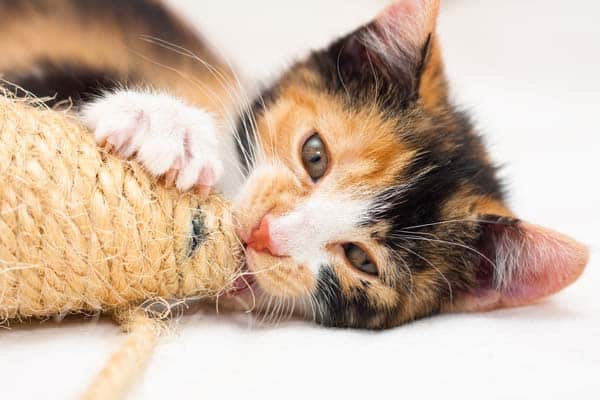Cat colors, patterns and fur length are a cat’s calling card. We include these characteristics when referring to specific types of felines. For example, we would call fictional cat Garfield a red tabby Exotic Shorthair.
Note the color, pattern, breed and coat length in the name. The cat fancy — or the community of feline enthusiasts, cat show judges, breed registries, breeders and others who study and adore felines — gave us these designations to make it easier to identify cats.
This may seem hard to believe, but cat colors basically include black, red, white or some combination, dilution or mixture of these. It almost doesn’t seem fair when birds get 15 vivid colors like pink, green, blue, yellow and purple.
“Birds derive their brilliant coloring because of the chemical structure of their feathers and amino acid modifiers, which is different from that of cat coat textures where pigmentation is based on melanin types,” says Joan Miller, the Cat Fanciers’ Association’s outreach and education chair and renowned cat expert.
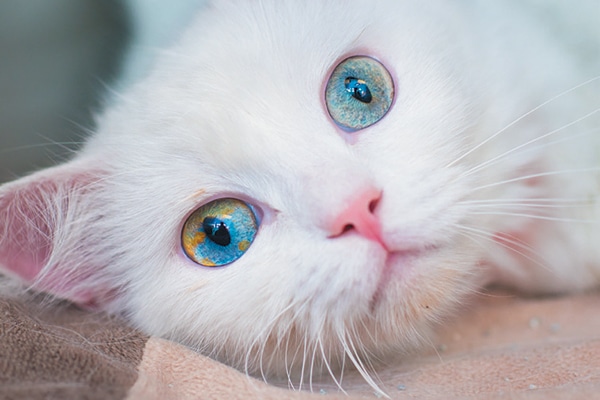
Cats basically come in black, red, white or some combination, dilution or mixture of these. Photography by Casey Elise Photography.
Cat colors — what coat colors can cats have?
Basically, when it comes to cat colors, cats are black unless they have inherited the sex-linked orange masking gene, in which case, they are red, Miller explains. By red, we mean what is commonly called orange.
“The hundreds of colors and patterns displayed in domestic cat coats come about because of modifying factors that include both genes and polygenes, which change these basic two colors,” she says, giving an example of the dilute gene, which changes cat colors from black to blue (commonly called gray) and red to cream.
Polygenes, genes that require multiple others of their kind for their effects to be observable, then determine whether the coat color tone will be a dark steel gray-blue or a pale powder blue, she explains. These inherited polygenes are controlled through selective breeding in pedigreed breeds. If you’ve studied cats for very long, you probably know that calico and tortoiseshell cats — those with both black and red coat colors — are female. That’s because the orange gene is carried on the sex-linked X chromosome. Because males are XY with only one X chromosome, they can only be black or red (or the variations of each due to modifying factors).
Since females are XX, they can be both black and red. “This is how we obtain the flashy tortoiseshell-colored females, who have black coats with splashes of red. If the dilute factor is inherited, the female cat will be a blue-cream. Should a cat also inherit the piebald white spotting factor, then this female can be a tortie and white bicolor, or calico tricolor cat with large black and red areas on a white coat,” Miller says. Piebalds are spots or patches that are absent of pigmentation, or white.
Read more about cat color and genetics on Paws and Effect >>
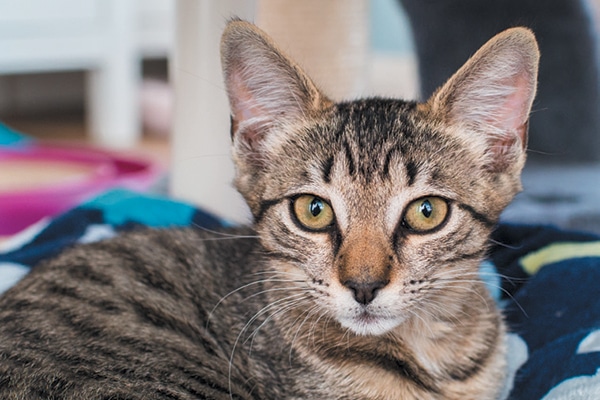
When it comes to coat patterns, here’s a mind-blowing fact: All cats start as tabbies. Photography by Casey Elise Photography.
The tabby pattern
When it comes to cat colors and coat patterns, here’s a mind-blowing fact: All cats are tabbies. “Whether they show their tabby pattern or not depends on whether the cat has inherited the dominant agouti gene or the recessive non-agouti solid color gene,” she explains. “However, even solid-colored red cats will show tabby pattern because the sex-linked chromosome is not affected by the non-agouti gene. Solid-color kittens will sometimes show their underlying tabby pattern when young before their kitten coat sheds and the adult coat grows in. Also, when an adult cat with a solid coat lies in bright sunlight their underlying tabby pattern can often be faintly seen.” The tabby pattern includes the characteristic “M” marking on their foreheads and four basic types:
- Classic tabbies, also called blotched tabbies, have a combination of stripes, swirls, blotches and what looks like a bull’s-eye on the sides of their bodies.
- Ticked tabbies have banding on each hair shaft with a lighter color at the base, which creates an iridescent speckled appearance but without stripes on the body. Abyssinians and Somalis are these types of tabbies.
- Mackerel tabbies have vertical continuous stripes on both sides of their bodies and a dark spine line extending from shoulders to tail.
- Spotted tabbies are just that. The size of the spots and the spacing between them vary. Ocicats have large thumbprint spots, Egyptian Maus have high-contrast, randomly placed spots of varied shapes and sizes, and Bengals have rosette spotting, according to Miller, “but random-bred cats will often have broken mackerel or classic striping giving a spotted appearance.”
- There’s also a pattern called patched tabby. These are female cats with any of the four tabby patterns but that also show additional red-colored patches due to their inherited sex-linked orange gene, Miller explains.
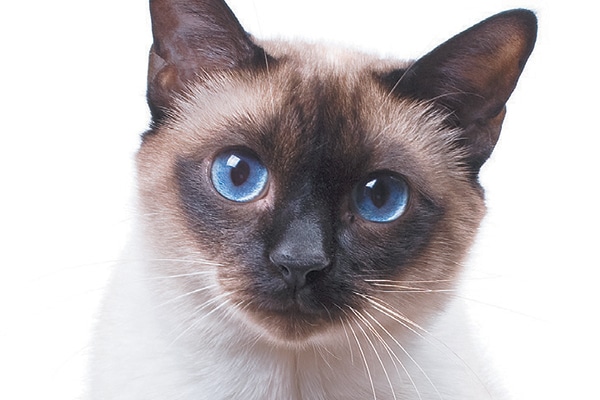
The point-restricted pattern gene gives Siamese and related breeds their pointed pattern, or a light-colored body with darker colors at the extremities. Photography ©studdio22comua | Thinkstock.
The pointed pattern
Here’s another cool point about cat colors: The point-restricted pattern gene gives Siamese and related breeds their pointed pattern, or a light-colored body with darker colors at the extremities. The gene must be carried in both the male and female for any of the kittens to be pointed.
“The gene is temperature sensitive, causing color to be restricted to the cooler extremities of the body — the face, ears, legs, tail and testicles,” Miller explains. “It is part of the albino series and modifies the color tone so that black appears dark seal brown on a light fawn-colored body. The genetic mutation, chocolate color, and its dilute version, lilac, also were seen in the early Siamese cats.” Tonkinese cats, which are a mix of Siamese and Burmese, have a more subtle point contrast called mink coloring.
Siamese cats were named after the ancient kingdom of Siam, where they originated. “These cats were a sensation when first imported to England in the mid-1800s,” Miller says. “When the Siamese first came to America in the early 1900s, they quickly became popular as pets, leading to the spread of the recessive point-restricted pattern throughout the country. It is still hidden in the genotype of many random-bred cats and surfaces in litters when both the sire and dam are carriers of the gene.”
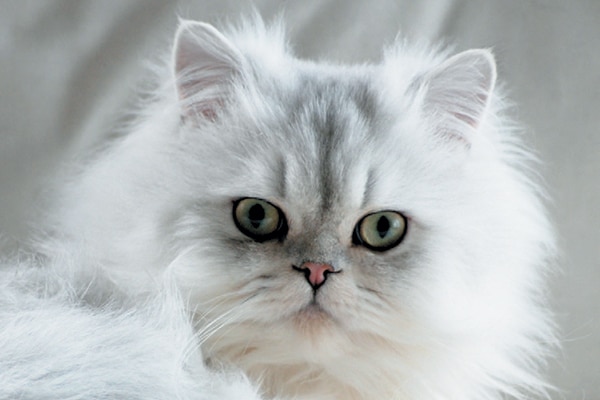
Three types of shaded cats include: chinchilla, shaded and smoke, each distinguished by
the extent of the shading on individual hairs. Photography ©Olivia | Thinkstock.
Shading patterns
Another thing to consider when we’re talking cat colors? Shading, which is characterized by color at the tips of the hair with a pure white undercoat. Three types of shaded cats include: chinchilla, shaded and smoke, each distinguished by the extent of the shading on individual hairs.
In chinchillas, only the very tip of the guard hair, or outer coat, is colored. With the shaded pattern, a quarter of the guard hair farthest from the cat’s body exhibits the color. In the smoke pattern, half of the guard hair farthest from the cat’s body displays the color. When a smoke-patterned cat is still, the coat pattern may appear solid, but when the cat is moving or you pet him, you can see the white undercoat.
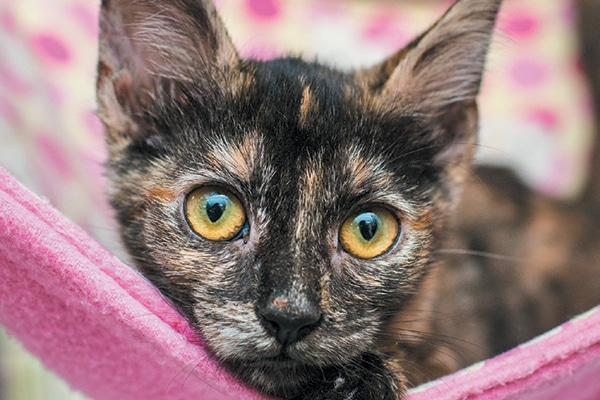
The tortoiseshell, or tortie, are referred to as particolored. These cats are female, and they’re black with random patches of red. Photography by Casey Elise Photography.
Bicolors and tricolors
With cat colors, people love to talk about bicolored cats, which are white and any other color. The cat can have a little spotting, even only one patch of white, or can be mostly white with a little bit of the other color. The colored area in bicolored cats can also feature any of the tabby patterns.
“The bicolor and tricolor patterns are created by the incomplete dominant piebald white-spotting gene,” Miller says. “Polygenes help determine the amount of white in the cat’s coat. Black bicolored cats with only a small amount of white, such as a ‘bib,’ white paws and perhaps a white facial ‘blaze’ are the ‘tuxedo’ cats. The other extreme is an almost entirely white body with color only on the tail and perhaps a spot or two on the head or body. This is called the ‘Van’ pattern referring to the cats found in the Lake Van area of Turkey centuries ago.”
Calicos are white females with large solid areas of black and red patches as well as other colors like blues and creams thrown in. They can have a little bit of white, a lot of white or anything in between.
Tortoiseshells, or torties, are referred to as particolored in the cat fancy. Like calicos, these cats are female, except they’re black with random patches of red. The black and red can also be the dilute blue and cream. A dilute tortie is a blue female with patches of solid cream or chocolate with red or lilac with cream. The patches on the tortoiseshell can also be tabby patterned.
Cat colors chart:
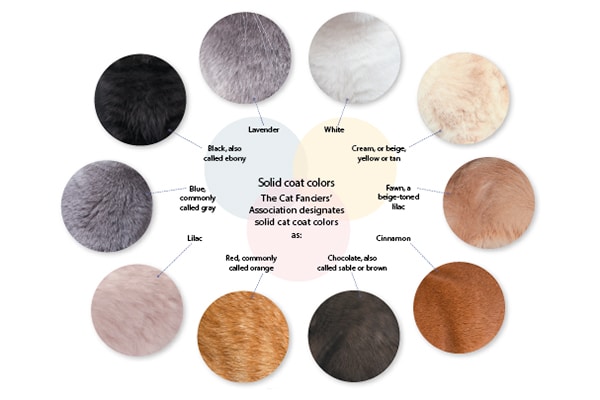
Solid coat colors in cats. Photography ©Thinkstock Images.
Cat colors and cat personalities
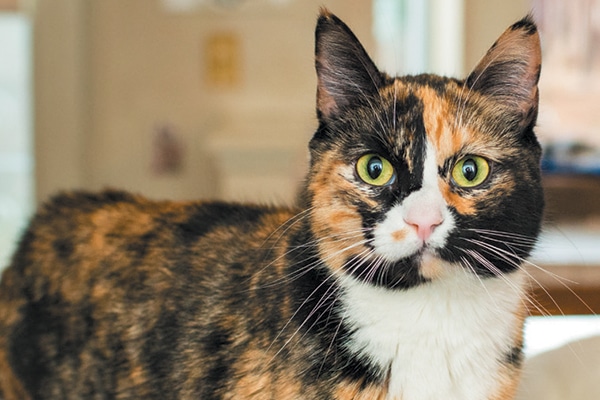
Calico and tortoiseshell cats are female, because the orange gene is carried on the sex-linked “X” chromosome. Photography by Casey Elise Photography.
The University of California, Davis, surveyed 1,200 cat guardians in 2015 and published the results in the Journal of Applied Animal Welfare Science. The respondents were asked to choose a color category that best represented their cat and to answer questions about cat colors and their cats’ behaviors. The results seemed to confirm a reputation that calicos and torties are feisty and unpredictable.
In another survey, researchers from the University of California, Berkeley, and California State University, East Bay, asked 189 cat guardians to assign the terms – active, aloof, bold, calm, friendly, intolerant, shy, stubborn, tolerant and trainable — to five different cat colors — red, tricolored, white, black and bicolored. The results showed that respondents were more likely to attribute friendliness to orange cats, intolerance to tricolored cats and aloofness to white cats.
Keep in mind that these were surveys of human perceptions, not scientific studies that controlled for other possible personality influencers, such as gender and coat length. Calicos and torties are female, which might play a greater role in personality than coat color. Longhaired cats are generally believed to be docile, while shorthaired cats are purported to be energetic.
I have two red tabby domestic longhaired cats who came from the same litter. Some of my friends can’t tell them apart, and one cat could work as a stunt double for the other. But when it comes to personalities, the two couldn’t be more opposite. One greets everyone who comes to our house; the other has enough love only for me and my husband.
More studies are needed before we can conclude that cat colors influence personality.
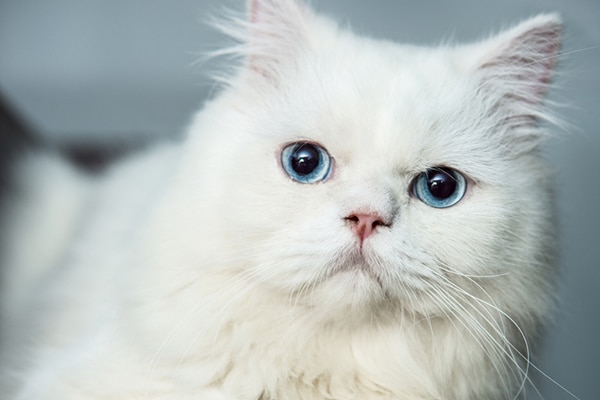
A blue-eyed white cat. Photography by DONOT6_STUDIO / Shutterstock.
Cat eye colors
Another cool point to consider when it comes to cat colors — cat eye colors. All kittens are born with blue eyes. At about 6 to 8 weeks of age, “their potential final eye color begins to become apparent,” Miller says. “Full brilliance is not achieved until a cat reaches maturity.” Full maturity can take one to two years, depending on the cat breed. “There are only three basic eye colors,” Miller says. “However, eye color of domestic cats is striking and greatly varied. Interestingly, the brilliant copper eye color of a Persian, the deep gold eyes of an Abyssinian or Bombay and the emerald green eyes of a Russian Blue are all derived from the same gene. It is through years of selective breeding that this extreme eye color spectrum has been perfected in the breeds. Random-bred cats usually have greenish gold or hazel eye color; however, a colony of free-roaming cats resulting from natural-line breeding will often develop golden or lemon-yellow eye color.”
Some cat eye colors are linked to coat colors or patterns. For example, white cats can have blue, yellow, gold or odd eyes. “Any cats that have inherited the piebald-spotting factor can have odd-eye color — one blue eye and one golden, yellow or greenish eye,” Miller says. Cats with the point-restricted color pattern, like the Siamese, have blue eyes because of a gene that is linked to albinism. Tonkinese often have aqua eyes. “Tonkinese showing the deeper Burmese coat colors (sable, blue, champagne or platinum) will have gold or green eye color,” Miller says.
Thumbnail: Photography by Xseon | Shutterstock.
This piece was originally published in 2017.
